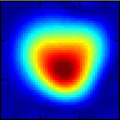

Chief Operating Officer Jim Krupnick has announced that the Lab is poised to enter contract negotiations with a private bus transportation vendor. "We have now concluded that the best route to enhanced safety for our employees, students and guests is to enter contract negotiations with an outside transportation vendor in the hope that a new bus service will be in place by early 2010," says Krupnick. The full text of the announcement, which further states that the Lab's 13 career bus drivers will either become employees of the vendor or given the option of ongoing, union-represented employment at the Lab with no cut in salary or benefits, is available here.

The shuttle buses will suspend their onsite routes from about 11:30 a.m. to 1 p.m. Offsite buses will continue service from Buildings 65 (Blue) and 74 (Green and Orange).
 People: Steve Louie Inducted Into Arts and Sciences Academy
People: Steve Louie Inducted Into Arts and Sciences AcademySteve Louie, a physicist with Berkeley Lab’s Materials Sciences Division and scientific director of the Theory of Nanostructured Materials Facility at the Molecular Foundry, will be inducted into the American Academy of Arts and Sciences on Saturday. This is the 229th class of new members for an organization that was founded in 1780 to celebrate pioneering research and scholarship, artistic achievement, and exemplary service to society. Louie is being recognized for his theoretical research in condensed matter physics and materials science. Joining him are Nobel Prize-winner gene researcher Mario Capecchi, California Supreme Court Chief Justice Ronald George, author Thomas Pynchon, actors Dustin Hoffman and James Earl Jones, and musician Emmylou Harris. More>
 Research: Hyper-SAGE Boosts MRI/NMR Signals; Detects Molecular-Sized Targets
Research: Hyper-SAGE Boosts MRI/NMR Signals; Detects Molecular-Sized TargetsAlex Pines, a world authority on Magnetic Resonance Imaging (MRI) and Nuclear Magnetic Resonance (NMR) led the development of Hyper-SAGE, a technique that can increase the strength of a remote MRI or NMR signal 10,000 times, making it possible to detect ultra-low concentrations of clinical and environmental targets. This enhanced sensitivity presents a path to the non-invasive imaging of lung and other cancers at their earliest stages. Working with Pines on Hyper-SAGE were Xin Zhou and Dominic Graziani of the Materials Sciences Division. More>
 Research: JGI Helps Establish Standard Definitions for Genome Sequences
Research: JGI Helps Establish Standard Definitions for Genome SequencesAs the proverbial “fire hose of data” becomes a Niagara torrent, and with conservative estimates of 12,000 draft genomes hitting the public databases by 2012, researchers may be surprised to find that these datasets describe genomes that are not complete. Recognizing the problem, a group of researchers from several sequencing centers, including Patrick Chain (pictured), a Joint Genome Institute scientist at Los Alamos Lab, has proposed a new set of standards that expand upon the so-called “Bermuda standard.” In a study published in the Oct. 9 issue of Science, lead author Chain and his colleagues proposed four additional categories between “draft” and “finished” terms currently used to classify genome projects. More>
 Special Event: Earth Sciences Hosts Seminar on the ‘State of the Carbon Cycle’
Special Event: Earth Sciences Hosts Seminar on the ‘State of the Carbon Cycle’ As part of its Distinguished Scientist Seminar Series, the Lab’s Earth Sciences Division will host a talk by Josep (Pep) Canadell, executive director of the Global Carbon Project. The event takes place Friday, Oct. 16, at 10:30 a.m. at the Goldman School of Public Policy on campus (1893 Leroy, at Hearst Ave., room 0150). The Global Carbon Project seeks to develop a complete picture of the global carbon cycle, including biophysical and human dimensions and their interactions. More>
 In Memoriam: Wladek Swiatecki
In Memoriam: Wladek SwiateckiNuclear scientist Wladek Swiatecki passed away last Wednesday after several months of illness. He was 83 years old. Swiatecki came to the Lab in 1957. He pioneered work on shell effects in nuclear binding energies and, in particular, nuclear surface and nuclear dissipation effects in the context of nuclear fusion and fission dynamics. He attracted worldwide attention by applying these insights to predictions of the stability of superheavy elements. The Nuclear Sciences Division hosted a symposium to honor Swiatecki's 80th birthday.
Today at Berkeley Lab is produced by Public Affairs' Communications Group